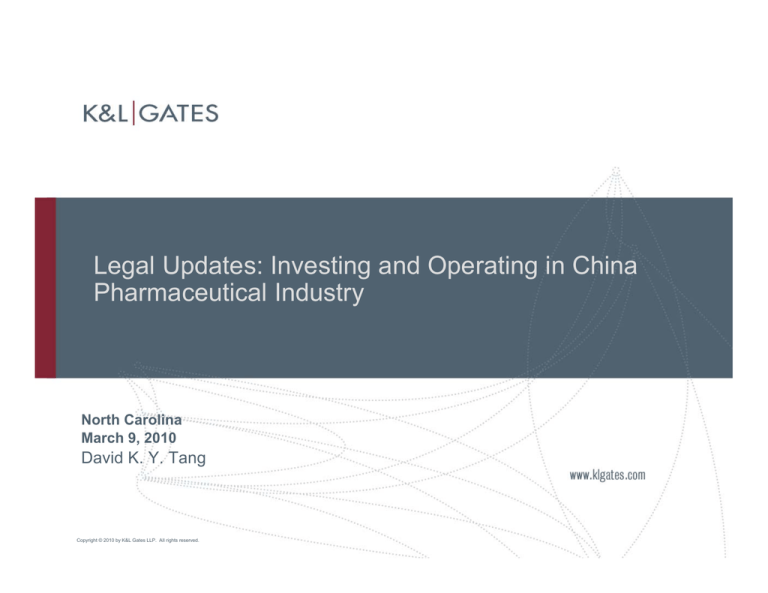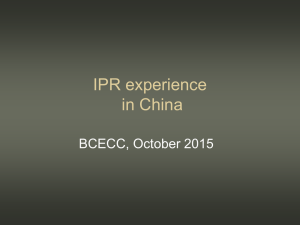Legal Updates: Investing and Operating in China Pharmaceutical Industry North Carolina
advertisement

Legal Updates: Investing and Operating in China Pharmaceutical Industry North Carolina March 9, 2010 David K. Y. Tang Copyright © 2010 by K&L Gates LLP. All rights reserved. Agenda Chinese market overview 2009 PRC Economy Chinese Pharmaceutical Industry Legal Developments in China Foreign Investment in China Non-Competition and Confidentiality Issues Tax Regulations Intellectual Property Rights 1 Chinese Market Overview 2009 Chinese Economy GDP increased 8.7% in 2009, has overtaken Japan and become the world’s second largest economy Foreign direct investment dropped 12.6% in the first 10 months of 2009 due to the Global recession 2 Chinese Market Overview Chinese Pharmaceutical industry Fast increasing market 1998 (Billion) 2007 (Billion) Increase Rate Turnover of medicine products (drug, medical device, etc.) RMB137.1 RMB667.9 387% Import amount US$1.5 US$14 833% Export amount US$3.4 US$24.6 624% Domestic pharmaceutical companies More than 3500 domestic drug companies, accounting for 70% of the market Most are generic drug manufactures—95% of Chinese pharmaceutical products are generic, which only take 2-4 years to launch into the market Chinese government encourages R&D of new drugs. However it will take 8-10 years to launch into the market 3 Chinese Market Overview Chinese Pharmaceutical industry Foreign Participants Among top 50 drug best-sellers in China, 40 are foreign brands Top 20 global drug companies have set up subsidiary and R&D centers in China (Pfizer, Merck, Roche, GSK, Novartis, Bayer) International CROs like Covance, Quintile, PPD have presence in China Investment in pharmaceutical industry in China Venue: Beijing / Shanghai Near regulatory agencies More talent available Pharmaceutical industrial development zone: Beijing Changping, Shanghai Zhangjiang 4 Chinese Market Overview Chinese Pharmaceutical industry Investment in pharmaceutical industry in China Cooperation with CROs in China International CROs: Quintile, PPD, Covance, and MDS Pharma Services have subs in Beijing and Shanghai Local CROs fast growing Some Chinese universities and research institutions have cooperative research projects with foreign companies Preferential Policies Preferential income tax for high-tech companies Exemption of import duties for research equipments and related technology and parts Increasing IP protection Local preferential policies 5 Foreign Investment in China – Introduction Four foreign investment industrial catalogues Encouraged Permitted Restricted Prohibited Four types of foreign invested enterprises Wholly Foreign Owned Enterprise Equity Joint Venture Contractual Joint Venture Representative Office 6 Foreign Investment in China--Pharma Industry 2007 Foreign Investment Catalogue Manufacture -- Classified as encouraged (16 types of products and 10 types of equipments), restricted (i.e. immunity vaccines, psychotropic, blood products) or prohibited (i.e. stem cells, gene therapy) categories, depending on the nature of the drugs to be manufactured in China Distribution – Classified in restricted category (Chinese party shall have a controlling interest for a chain, which has 30 or more branch stores and distributes different varieties and brands of products from two or more suppliers ) 7 Foreign Investment in China--Pharma Industry 2007 Foreign Investment Catalogue Drug Research and Development Encouraged -- Biomedical Engineering Technology is classified in encouraged catalogue Restricted – Generally no restrictions. Clinical trial: the sponsors (foreign pharma R&D centers or CROs) cooperate with investigators (qualified medical institutions) to implement clinical trial. The medical institutions are in restricted catalogue, wholly foreign invested medical institutions are not permitted. Prohibited -- R&D and application regarding stem cell and gene diagnosis and treatment are prohibited for foreign investment Private Hospitals – Limited to Joint Venture only 8 Foreign Investment in China- Legal Updates New Requirements on Rep Offices Notice on Strengthening Administration for Registrations of Foreign Enterprises Resident Representative Institutions (effective on Jan 4, 2010) New application documents required for establishment or name alternation No more than four representatives One year validity term of registration certificate 9 Four limitations on non-competition under Chinese Labor Contract Law Non-competition term shall not exceed 2 years; Geographic scope shall be reasonably agreed by employer and employee; Upon termination of the employment, the employer shall pay employee economic compensation on a monthly basis during the agreed non-competition period; The persons subject to non-competition shall be limited to senior mangers, senior technicians, and other employees, who have the obligation to keep secrets of employer. 10 Non-competition and confidentiality agreements with employees Payment of economic compensation No national standard of calculation of consideration-pursuant to Labor Contract Law: “agreed by both parties” Some local rules provide minimum statutory consideration–usually a percentage of employee’s total annual income before the termination date of employment 11 Non-competition and confidentiality agreements with employees Enforcement problem of non-competition agreement In case violation of non-competition agreement happens, since there are no pre-judgment injunctions under PRC civil procedure laws, it can take one year or more to complete the arbitration or litigation process 12 Tax Regulations -- Enterprise Income Tax New Enterprise Income Tax Law Effective January 1, 2008 Flat rate of 25% Tax preferential treatment High-tech enterprises: 15% The incomes incurred from the certain technology transfer: exempted or reduced 13 Thresholds for recognition of High-Tech enterprises: Registered in China (excluding Hong Kong, Macao and Taiwan) and has independent intellectual property in core technologies in its key products/services; The products/services are within the Nation Supported High-Tech Category, including electronic information technology, biopharmaceutical technology, aerospace engineering, new material technology, new energy and environment technology and high-tech services; Scientific and technical personnel with an undergraduate degree or higher account for at least 30 % of the total employees, of whom R&D personnel account for at least 10 % of the total employees; 14 Tax Regulations Thresholds for recognition of high-tech enterprises: R&D expenditure during the recent 3 accounting years shall be no less than certain percentage of the total revenue: Sales Revenue R&D expenditure proportion < 50 million RMB ≥ 6% ≤ 50 million RMB < 200 million RMB ≥ 4% ≥ 200 million RMB ≥3% Revenue generated in high-tech products/services accounts for at least 60% of its total revenue; and Certain requirements regarding R&D management, capacity to commercialize scientific and technological achievements, number of independent IP rights, growth in sales and total assets 15 Tax regulation – Transfer pricing Measures of Special Taxation Adjustments (Provisional) (issued on January 2, 2009) Notice of the State Administration of Taxation on Intensifying the Transfer Pricing Follow-up Administration (issued on 16 April 2009) Background – in connection with multinational company’s arrangements without reasonable commercial purpose Highlights of the new regulations Contemporaneous documentation and related-party annual filing Transfer pricing investigations and adjustments 16 Intellectual Property Rights-- Introduction Protecting IP in China: a cynic’s perspective Why bother? What’s the point? Is it really possible? Is there any Chinese interest in protecting IP? 17 Intellectual Property Rights-- Introduction IP Legal Framework Patent law - April 1, 1985, amended in 1992, 2000 and 2008 Trademark law - March 1, 1983, amended in 1993 and 2001 Copyright law - 1990, amended in 2001 Trade Secret Protected by Unfair Competition Law - 1993 and amendment under consideration WTO / TRIPS (2001) 18 Intellectual Property Rights-- Introduction Scope of protection Duration Formalities Inventions, Industrial designs, Utility models Fairly limited (20 years or 10 years) Application required Does not cover “ideas” within a work Fairly long (Lifetime of the author plus 50 years) Subsists at creation (but registration is beneficial) Trademark Words, symbols, designs… No protection on trade dress 10 years (renewable) Application required Trade secret Covers a very broad range of ideas, expression, plans, etc. but must remain secret Can be infinite Must maintain secrecy of trade secret material Patent Copyright 19 Intellectual Property Rights-- Introduction IP Enforcement Authority Judicial Action Civil Action -- Civil (IP) division of the local People’s Court Criminal Action -- Criminal division of the local People’s Court (only local procuratorate office can file a criminal case) Administrative Action Copyright infringement - National Copyright Administration of China Trademark infringement - State Administration of Industry and Commerce and its local offices Patent infringement - State Intellectual Property Office Customs - Investigation and detainment of exporting/importing infringed goods 20 Intellectual Property Rights– Legal Updates Patent Protection New SIPO Statistics: 976,000 patent applications in 2009, 90% are domestic applications, foreign applications went down 10.9% New Legislation 3rd Amendment of Patent Law (eff. October 2009) Implementing Rules of Patent Law (issued January 2010) Interpretation on Several Issues Concerning the Application of the Law on Trials of Patent Infringement Disputes (eff. January 2010) 21 Intellectual Property Rights– Legal Updates Trademark 3rd Amendment to Trademark Law is being drafted Bad-faith registration problem Enforcement of IP First IPR Court (rather than IP division in People’s Court) established in Zhuhai National Hi-tech Industrial Development Zone on an experimental basis Experiment to uniformly handle criminal, civil and administrative lawsuits regarding IPR, which are responsibilities of criminal, civil and administrative divisions in other traditional People’s Courts 22 Intellectual Property Rights – Strategies/Summary Have a comprehensive IP strategy before entering the market. File/register your IP as early as possible. Internally: Employees should be aware of importance of IP protection. Core IP design/info should be housed in home country. Build relationships with officials in IP specific bodies and in the company’s industry. 23 High Tech/ Internet Business Restrictions for foreign investor Value-added telecom services--foreign capital shall not exceed 50%; Mobile voice and data services in basic telecom services--foreign capital shall not exceed 49%; Domestic and international business in basic telecom services-foreign capital shall not exceed 35%; News websites, internet audio and video programs, business places for surfing internet (i.e. internet cafe), and operation of internet culture are prohibited in 2007 in Foreign Investment Catalogue In practice: Some multinational companies, i.e. Yahoo, Google have entered into Chinese market through special contractual arrangements. 24 Google - IP Theft and Censorship Google considered leaving the China market after IP theft in January 2010 and limitations of censorship, but remains in China. Factors? Politics Business Necessity/Survival Publicity New Business Model/Competition 25 Practical Operations Office/Science Parks Dispute Resolution Business/Social Etiquette 26 Business/Social Etiquette - Broadly Gifts/ Guanxi and FCPA Nonverbal cues - Attitude/Respect Authority/Saving Face 27 Questions? David K.Y. Tang Managing Partner, Asia Beijing +86.10.8518.8528 david.tang@klgates.com Thank You 28 29






